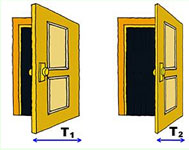…A SPATIOTEMPORAL ONE…
Stage 61 / Friday 26 June / From Tardajos to Hontanas / 21 km
Oh joy: this morning a kind pilgrim, but German-speaking, left a note on the corner of the kitchen table before setting off on the path at dawn: “Coffee is nearby [près in French]!” Her intention was clearly to notify the French-speaking pilgrims – including me – that she had left hot coffee in the thermos-pot at our disposal in the refugio (the word for hostel in Spanish). She meant to write: “The coffee is ready [prêt]!” This friendly spelling confusion (both are pronounced exactly the same: pray) launched me into a spatiotemporal meditation: for the coffee was not only “near” the table (spatial connotation: it’s not far), but it was also hot and “ready” to be served (temporal connotation: don’t waste time in preparing it)!
So that’s what launches my stage on the possible relationship between time and space. Before tackling the theory of relativity, I see here the fact that the coffee being already ready, the pilgrims setting off in motion this morning will be able to leave earlier, thereby covering more space in the walk today, at least if they want to. Therefore, for them this time saved will not be “money” earned, but will be a greater “distance” possible to cover. Time is distance!
Now, since time is affected by movement, space is equally so! In the theory of relativity, the genial Einstein demonstrated that a contraction of space and a slowing of time accompanied a very high velocity. If you could observe a rocket (60 meters long and 10 meters in diameter at rest) start taking off until it would reach a speed close to ¾ of the speed of light, you would notice that this rocket (still 10 m in diameter) contracting in length to only 40 meters! And a clock carried in this very fast movement would seem to slow down in relation to an identical but immobile clock left back on earth!
Thus we know that time flows differently the closer one gets to the speed of light, and it is proven. I wouldn’t be able to tell you how and why, but I remember that sometime during my studies, I believed I had fleetingly understood it … This has to do with the fact that the speed of light-wave propagation never varies regardless of the speed of the reference point from which one observes it. You can imagine it thanks to the following image of the partly opened doors.
In space-time, duration becomes a dimension like the three others in space. Imagine that this time-dimension is the equivalent of the apparent width of a door. Imagine that the speed at which you observe it, the door is closed (V = 0) or partially open (V) or open (V = c, the speed of light). The apparent size of the door T1 or T2 diminishes whether one is at speed V1 or V2 which are faster and faster.
Now imagine that the (relative) length of the rocket can be seen like the apparent size of the door, and you will understand that 60 meters can look like 40 in the direction of the displacement! And imagine the duration (the measure of time on the clock aboard the rocket) as the door fully-opened. It will be slowed down more and more as it approaches the speed of light c which can never be surpassed! This will be as if the contraction of space were caused by a spring-latch resisting more and more and slowing the opening as one approaches the speed of light c! |
 |
I have spoken of the capacity of space to contract and of time to expand in certain conditions of rapid movement. Now at the other end of the cosmological ladder, the new quantum physics teaches the principle of uncertainty discovered in 1927 by Werner Karl Heinsenberg (1901-1976): one cannot determine with precision both the position and the speed of a particle at the same time. One can never even measure them simultaneously, even with the greatest progress in measurement instruments! The world of the infinitely small thus escapes measuring and therefore prediction. We must go back to statistics and probabilities. All that we know is that there are certain chances of finding the particle in a given place, and that’s all! It can be there, but it can also not be there, and a calculation of probability can give the percentage of chance that it will be there, or not! …
Albert Einstein (1879-1955) didn’t like fact that the world seems subject to chance. In 1927, invited to the fifth Solvay congress, he had numerous conversations with Niels Bohr (1885-1962) on this subject. He said then, “Gott würfelt nicht” [God doesn’t play with dice] to indicate his opposition to the probabilistic interpretation of quantum physics, to which the other scientist Niels Bohr quietly replied, “Who are you, Albert Einstein, to dare tell God what He should do?”
The fact remains that that is where we still are: if it is illusory to know with certainty the position of a particle in space, and if space and time are connected, does that mean time itself is illusory? What we perceive in reality is not time passing more or less quickly but the changing of position in space. Now, although there exists broad consensus between the observations of different humans on a grand scale (yes the sun does rise in the east), no one is capable of verifying with certainty the position of a particle, and that should make us a bit more humble than we generally are! This confirms that the future is unpredictable, so much the better! One never knows what may appear in our spatiotemporal desert …
And it is less “haunted” by the absurdity of a world whose spatiotemporal future would be completely predetermined that I enter Hontanas …








